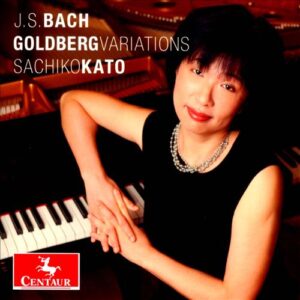 Japanese-American pianist Sachiko Kato shows an extraordinarily light touch on the keys that serves J. S. Bach’s Goldberg Variations very well. The Osaka native who grew up in Los Angeles and studied at Juilliard, where her teachers included Russell Sherman and Jerome Lowenthal, cultivates a quickness in these variations that makes them move through our consciousness with a fleetness that does not preclude the time necessary for their immense musical and philosophical riches to make its impression. So lightly do her hands move across the keyboard that she recalls the original instrument for which Bach wrote this set of variations, the harpsichord, without actually attempting to replicate its sound (which would be both impossible and undesirable). Under her hands, what often appears in other recordings to be ponderous and labored soars toward heaven and plunges to the depths. At 59:15, as opposed to around 75 minutes for many competitive versions, these Goldberg Variations hardly seem to have begun before we reach the final Aria da capo. All the more reason to encore them!
Japanese-American pianist Sachiko Kato shows an extraordinarily light touch on the keys that serves J. S. Bach’s Goldberg Variations very well. The Osaka native who grew up in Los Angeles and studied at Juilliard, where her teachers included Russell Sherman and Jerome Lowenthal, cultivates a quickness in these variations that makes them move through our consciousness with a fleetness that does not preclude the time necessary for their immense musical and philosophical riches to make its impression. So lightly do her hands move across the keyboard that she recalls the original instrument for which Bach wrote this set of variations, the harpsichord, without actually attempting to replicate its sound (which would be both impossible and undesirable). Under her hands, what often appears in other recordings to be ponderous and labored soars toward heaven and plunges to the depths. At 59:15, as opposed to around 75 minutes for many competitive versions, these Goldberg Variations hardly seem to have begun before we reach the final Aria da capo. All the more reason to encore them!
Whether or not we believe the story that Bach wrote the variations for a certain Count Kaiserling who was plagued by insomnia, the fact remains that this music (with no attempt at disparagement) is the perfect prescription for that malady. When we experience insomnia, it is because our minds are too active at bedtime. What we need is not the soothing smarm of musical “wallpaper.” On the contrary, we need something to engage our mind, our imagination, and all our senses, to address the total person and give it a real workout. The Goldberg Variations do this better than any other music that I know.
From the opening Aria that forms the basis for the 30 far-ranging expressions of musical imagination that are to follow, Kato makes her presence felt. The Aria itself, a Sarabande in ¾ time with tastefully expressive ornamentation, seems to promise infinite riches for further development. We are not disappointed. Bach continually presents us with engaging contrasts. Var. 13, for example, a slow, gentle Sarabande with a melody in 32nd notes embellished by swelling tones (appoggiaturas) and the later addition of a second voice, appeals to the inner person, while the succeeding Var. 14, a rapid toccata with many trills and other ornaments that requires considerable hand-crossing, was described by Glenn Gould (one of Kato’s heroes) as “one of the giddiest bits of neo-Scarlatti-ism imaginable.”
When we get to Var. 25, an Adagio in two parts, we have arrived at the deep-water mark of the set. Wanda Landowska characterized it as the “black pearl” of the Goldberg Variations. Gould described this world-weary cantilena as “a master-stroke of psychology,” occurring at the precise moment in the set that it does. As we listen to the thoughtful way Kato approaches this solid synthesis of deep beauty and dark passion, and especially in the way we almost gasp when the second part occurs so unexpectedly (and so rightly), we are in the presence of one of music’s great treasures.
-Phil’s Classical Review (Audio Video Club of Atlanta)
